
When I started running, I thought I knew everything.
I put on my shoes and just got started. Every day, I’d run hard and fast and try to beat the record of the previous day. I always ended up extremely tired.
It wasn’t fun.
I believed that is how running was supposed to feel in the beginning and hoped it will get easier someday.
Well… it did not.
And I also got injured a few times which was inevitable.
It was a knee injury that got me thinking. And I started looking for information on how to start running properly.
It didn’t take me too long to realize:
There is a lot more to running than just running.
So I decided to write this article based on what I learned. I hope it will be helpful for at least a few beginners.
Let’s begin by looking at what you need to do if you want to run a race?
- You’ll need a running base.
- Then you’ll need to follow a running plan to peak for your race
- And finally, recover from the hard training.
This is how athletes train. They organize their training into short specific periods to avoid overtraining and gain the maximum benefits.
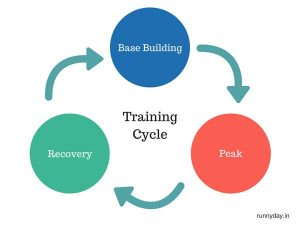
This way of organizing training is also called periodization. Typically, there are three periods in an athlete’s training cycle – base building, peak, and recovery.
Base building is the foundation which prepares a runner to handle the stress of future training. After establishing a solid base you’ll follow a training plan that will peak you for your targeted race(s). And finally, you need to recover before starting a new training cycle.
Let’s explore each phase in more details:
Running Base: Building the Foundation
What is a running base?
Running puts a lot of stress on our bodies. We need to prepare our body to handle that stress. That is exactly why a running base is required. Running base is the foundation we need to support the load of volume and intensity of our future training.
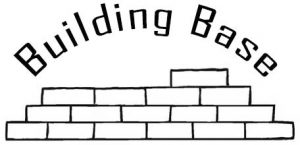
Do I need a running base?
Absolutely. It is necessary for every runner, new or veteran alike.
Before we begin, let’s understand what training is. Basically, all training can be broken down into three things:
- Frequency: How many times per week you run.
- Volume: How much distance you cover per week.
- Intensity: How easy or hard your effort will be.
Think about these as stressors that we put on our body.
Now, imagine introducing all three of them at once. Let’s say we start running every day (frequency), for as long as we can (volume). And every single time we run hard and fast (intensity).
This is a lot of stress. Our body is not prepared to handle it yet.
Result?
Injuries… pain… and disappointment. Sadly, this is how most beginners start.
So how should we start then?
By organizing our base building training into three phases. In each phase, we’ll introduce one stressor, get used to it and then move on to the next.
Tip for absolute beginners
 If you have never run before or you’ve been inactive for a long period of time – Couch to 5k is a great place to start. It’s a nine-week running program which has 3 running sessions per week. And those sessions include walking and running. At the end of the program, you’ll be able to run 5km comfortably. You can download the app for your Android or iPhone.
If you have never run before or you’ve been inactive for a long period of time – Couch to 5k is a great place to start. It’s a nine-week running program which has 3 running sessions per week. And those sessions include walking and running. At the end of the program, you’ll be able to run 5km comfortably. You can download the app for your Android or iPhone.
Start with 5km or about 30 minutes of running (regardless of the distance).
Then you need to decide how many days per week you want to run? The more is better. But make your decision based on your fitness level, goals and lifestyle. It’s up to you.
For the sake of this example, let’s say you want to run 6 days a week. We’ll achieve this goal in the first phase of our training.
Phase 1: Introducing frequency
In this phase, we’ll introduce the first stressor – frequency.
The goal is to get comfortable with running 6 days per week. And we’ll do so gradually.
- Start by running every alternate day with a rest day between each session. So you’ll be running 5 kilometers, 3-4 days a week. Continue this for at least 3 weeks.
Then add one day and maintain for 3-4 weeks. Repeat this until the goal of six days a week is achieved. Then maintain it for the next 3-4 weeks.
Note:
- Do not worry about distance and intensity yet. If you have to run less than 5 km on a day, that is fine. Or if you feel tired – walking during a session is perfectly fine too. Remember, the only goal of this phase is to get used to the frequency.
- Why three weeks? This period allows your body to adjust to one particular stress and benefit from it. Once you get used to it, you can introduce more demanding stresses and apply the same procedure to get the most out of your training. Please note this is a general recommendation. If you need more time to adjust – do that.
Phase 2: Volume
Now we’ll introduce stressor number two – the volume.
In this phase, we’ll do the following:
- Establish a baseline mileage – The distance you wish to run each week (or this is the mileage required by the running plan you want to follow). Add distance to 2-3 runs of the week.
- Introduce a weekly long run. A long run should be 25-30% of your total weekly mileage and no longer than 35%.
- Take a recovery week every 4th or 5th week. In recovery week, you should run 10-30% less distance than your baseline mileage.
There is no one set method of adding mileage. The most important thing is, it should be done gradually. Below are two approaches you can take:
Method 1: 10 percent rule
10 percent rule simply says you should add no more than 10% per week to your total weekly mileage. So if you are running 30 km a week and want to reach 60 km, here is how you can do it with this method:
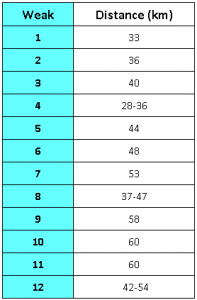
Keep in mind that there are times when it is better to increase mileage more or less than 10%. This is the reason many runners think this rule is flawed.
Method 2: Jack Daniels approach
Former Olympian, coach and author of the book Daniels’ Running Formula, Jack Daniels suggests you add 1 mile or 1.5 km for every run you do a week.
So if you are running 6 days a week, you’ll add 6 miles (~10 km) and hold that for at least 3 weeks. Repeat the same process until you reach your goal.
So, with this method, this is how your progression might look like:
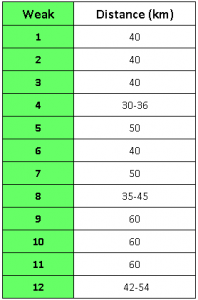
Easy running
Keep in mind, in the beginning, 100 percent of your running should be easy.
How easy?
A good rule of thumb is – you should be able to hold a conversation with your running partner if you are running with one. That’s why it is also called “conversational pace”.
You shouldn’t be out of breath during and after your easy runs.
For some people, slowing down is not that easy. They are not used to it. It takes practice. You’ll want to run hard and fast but don’t! Save your toughness for later… those days will come.
At this point, you just want to get comfortable with running.
Even professional runners do a lot of easy running. It makes a huge part of their training (about 80-85%). Easy running helps a runner recover from hard workouts which is crucial for gaining the maximum benefits of training.
Phase 3: Intensity
After achieving the frequency and volume targets, the 3rd phase of the training begins.
Add some high-intensity workouts such as tempo runs, intervals etc. Keep the mileage the same.
Please note that all these different types of runs have a specific purpose and there is a certain way to perform them. They need the right recovery time and they are limited to a certain percentage of the total weekly mileage.
You can use online tools to calculate your training paces.
Here are the two that I like:
And here is how to use them:
Run 1 mile (1600 meters) as fast as you can and input your pace into one of these calculators to check your pace for the different types of runs.

Click on “Calculate”.
And right below you’ll see three tabs – Race Paces, Training, and Equivalent.
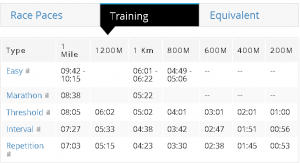
The “Training” tab will show you what your pace for different types of running workouts should be. And the “Equivalent” tab shows you times you can expect for other races based on your current pace.
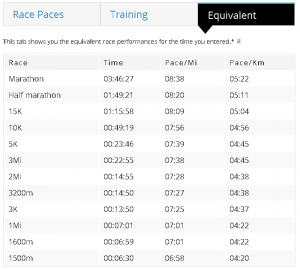
You can also use the Runner’s World training pace calculator in the same way. Input your race distance and pace:
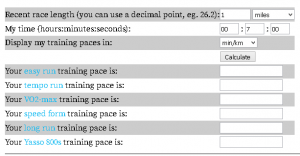
Hit “Calculate” button. You will see your suggested paces for different runs with descriptions of each.

Hard/easy pattern
Alternate hard days with easy days. Don’t run two back to back hard days. This allows you to recover from the stress of high-intensity workouts. Without sufficient recovery, you’ll not get the benefit of your workouts and there are good chances of you getting hurt.
Strides
Strides are great for improving running form and speed. You can incorporate them at later stages of your base building phase. Strides can be done in the middle or at the end of your easy runs.
Here is how to do strides:
- Start slow and build up the speed gradually (do not sprint).
- Hold the top speed for about 2-3 seconds.
- Then bring it down to a stop.
Do this for about 80-100 meters (or 15-20 seconds), with a recovery period of 1-2 minutes. You should do 4-8 strides per session 2-4 times a week. And do not worry about speed. Just focus on your running form.
Peaking: Choosing a running program
With a solid foundation, you can follow a running plan that will make you peak for your chosen race(s). Choose a running program based on your experience, your goals and make sure you will be comfortable following it.
 You can also make your own plan if you have sufficient knowledge.
You can also make your own plan if you have sufficient knowledge.
Recovery: What to do after a race?
You built a solid running base, followed a running plan and finished a race.
Now what?
Now you need post-race recovery.
This is the time to allow your body to recover from the intense training and the race(s) you just completed.
How much rest and recovery do you need?
This will depend on your running experience, race distance, your effort and how you feel. Each individual requires a different amount of time to recover.
One common formula for post-race recovery is one day for every mile raced. So that would be 26 days for marathoners, 13 days for half marathoners, 6 days for 10k runners and 3 days for 5k runners.
Remember, these are just examples. Recovery time varies from person to person.
After resting for a few days, if you are feeling well and you have no concerns – you can begin with easy running. Choose a moderate weekly mileage and stick with it before starting a new training cycle.
Important Things to Consider
Clothes
Although you can start running in anything you have, investing in clothes that are made especially for running (technical apparel) can make a big difference. While cotton clothes hold the sweat, technical clothes wick the sweat away from your body. They are also pretty light-weight.
Running Shoes
 Running shoes are the most important gear when it comes to running. This beginner-friendly running shoe guide will help you find the right pair for you.
Running shoes are the most important gear when it comes to running. This beginner-friendly running shoe guide will help you find the right pair for you.
And then you can pick the running shoes that will suit you best. Check out this article about the best running shoes and see if you can find a nice pair there.
If you have a low budget, check out the following guides:
Documenting Your Runs
Don’t forget to document your running sessions. Keeping track of your progress will motivate you. You can start by downloading a running app on your smartphone or buy a running watch.
Running Form
Incorrect running form is one of the leading causes of injuries. Pay attention to your running technique. Some cues to good running form are:
- Lean slightly forward
- Keep your head, neck and shoulders relaxed
- Arms bent at about 90 degrees angle at the elbows. And swing forward and backward not side to side.
- Plant your foot below your body with a bent knee (not with a stretched out leg)
- Do not overstride. Increasing your cadence can help big time.
- Arms and shoulders relaxed, no clenched fists
You can also perform some running drills 2-3 times to improve your running form.
Warm up
A warm-up wakes your body up and prepares it for running.
Always warm up before starting a run. Start by doing some dynamic stretches and do a brisk walk or jog before you start your running session.

Cool Down and Stretching
End your session with a slow jog or walk to cool down.
After finishing a running session do some static stretches. Remember, static stretches should never be done before a workout.
Cross Training
Cross training can help beginners a lot by strengthening the muscles required for running. You can do it on your rest days or easy days. Cycling, swimming, bodyweight exercises or weight training in the gym are good choices.
Remember, cross training should be done at an easy effort level. It should be supplemental to running.
Listening to Your Body
You might have heard it a lot. But it’s undoubtedly the best advice.
Every runner is different. Our bodies respond differently to certain stresses. You need to listen to your body and let it guide you. Adjust your training accordingly to stay injury free.
Rest, Rest, Rest
As I mentioned before, running puts a lot of stress on our bodies. Our bodies need rest to recover. Rest as much as you can. Try to sleep for at least 8 hours. Learn to take naps during the day.
Diet
Diet is a huge topic in itself. You’ll need to figure out what works for you and what doesn’t. Just stick with the good old advice – Avoid junk food and eat lots of fruits and green vegetables.
Carbohydrates are the fuel for runners that’s why runners are recommended a high carb diet. Make sure you get sufficient of other macros (protein and fat) too.
Hydration
Hydration is super important. Keep your body well hydrated to stay healthy and in your best shape.
Safety
Be careful when you are running on roads. If you run with music keep it low so you can hear the surrounding noise clearly.
If you run on the roads, always run against the traffic. It’s easier to see the vehicles coming from in front of you rather than assuming people will always see you from behind.
Be Consistent
Consistency is the key.
This is pretty obvious but extremely important to point out. Whatever activity you choose to do, you become good at it by being consistent. The process takes time. If you completely stop at some point, you’ll have to start from zero the next time you begin. And believe me, it’s not fun.
And remember…
Everything about running is debatable. You’ll always hear different opinions on certain topics.
Running is a very individual sport. What works for one runner doesn’t mean it will work for everybody else. This is true to almost every aspect of running – from running shoes to running technique and everything else.
In training, the most important thing you can do is – not get injured. You need to stay fit to train consistently.
Always introduce changes gradually whether to your form, training or gear. Be careful about it.
Running is a discovery. Ultimately it all comes down to you. You need to explore and figure out what works for you and what does not.
I hope this guide has been helpful for at least a few beginners. If you feel I missed something important, please share in the comments.
Happy running!
Sources:
- A Runner’s Guide to Base Building. Active.com
- Building Base Mileage. davidhays.net
- How Strides Work. howstuffworks.com
- Running Order of Operations-How far? How fast? How often? A Guide to Frequency, Intensity, and Volume (pdf). drive.google.com
- Daniels’ Running Formula by Jack Daniels
- Intervals, Threshold, and Long Slow Distance: The Role of Intensity and Duration in Endurance Training. sportssci.org


Glad to find this site- i had foot surgery a year ago (lisfranc injury) and want to return to running. i’ve been walking 10k 3 x a week with 10- 15 minutes easy running after 8k of walking. i want to be able to go back to running 10ks easily but the dream is to do a full marathon!